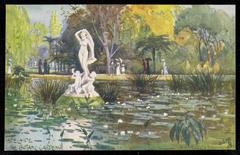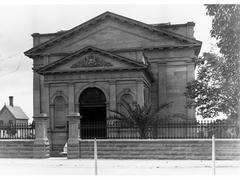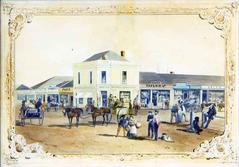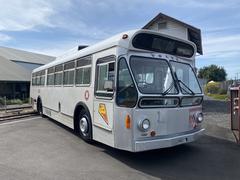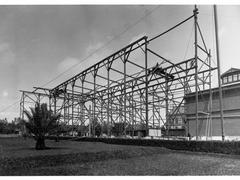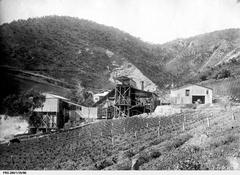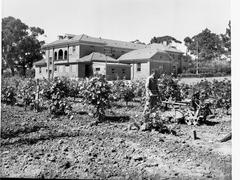
Mary MacKillop Bridge Adelaide: Visiting Hours, Tickets, and Travel Guide
Date: 04/07/2025
Introduction
The Mary MacKillop Bridge in Adelaide, South Australia, stands as an emblem of modern engineering interwoven with cultural and spiritual heritage. Named after Saint Mary Helen MacKillop, Australia’s first canonized saint, the bridge embodies values of service, resilience, and inclusivity that she inspired across the nation. Officially opened in 2008 alongside the Tom “Diver” Derrick Bridge, this bascule railway bridge plays a vital role in Adelaide’s transport infrastructure by enabling smooth freight movement across the Port River. While the bridge itself is not open to pedestrian traffic, it is easily admired from nearby riverfronts and forms part of significant heritage and pilgrimage trails, connecting visitors with the story of Mary MacKillop and Adelaide’s rich history (Wikipedia; Transportation History).
This comprehensive guide covers the bridge’s historical context, cultural significance, practical visitor information, nearby attractions, and tips for heritage travelers and pilgrims. Whether you’re interested in engineering, history, or seeking a meaningful journey through Adelaide’s historical sites, the Mary MacKillop Bridge offers a unique window into the city’s past and present.
Table of Contents
- Historical Background
- Cultural and Spiritual Significance
- Visitor Information
- Pilgrimage and Heritage Walks
- Frequently Asked Questions (FAQ)
- Visuals and Media
- Conclusion and Travel Tips
- References and Further Reading
Historical Background
Conception and Construction
Mary MacKillop Bridge was constructed as part of a major infrastructure plan to modernize Port Adelaide’s rail and road connectivity. In 2005, the South Australian Government awarded the contract for both the Mary MacKillop Bridge and the adjacent Tom “Diver” Derrick Bridge. The initiative aimed to divert the Dry Creek–Port Adelaide railway line away from the congested Rosewater loop, thereby streamlining freight transport to and from the port (Wikipedia; Transportation History).
The bridge was officially opened on 1 August 2008, marking a significant improvement in Adelaide’s transport logistics and further cementing Port Adelaide’s reputation as a critical freight hub.
Engineering and Design
The Mary MacKillop Bridge is a bascule bridge, featuring a moveable span that can be raised to allow maritime traffic to pass. This solution balances the needs of rail and river transport, supporting both economic activity and the city’s longstanding maritime traditions. The bridge carries the Dry Creek–Port Adelaide railway line and is managed by the Australian Rail Track Corporation. Positioned strategically between Docks 1 and 2, it improves freight efficiency while standing as a testament to contemporary engineering (Port Adelaide Historical Society).
Cultural and Spiritual Significance
Honouring Mary MacKillop
The bridge is named for Mary Helen MacKillop (1842–1909), a pioneering educator and co-founder of the Sisters of Saint Joseph of the Sacred Heart. Her tireless work in education and welfare, particularly among the marginalized, left a lasting legacy throughout South Australia. The naming of the bridge is a tribute to her enduring influence and commitment to social justice (Mary MacKillop Adelaide).
Port Adelaide’s Bridge-Building Tradition
Mary MacKillop Bridge continues a long tradition of significant bridge-building in Port Adelaide, following iconic structures like the Jervois and Birkenhead Bridges. Located beside the Tom “Diver” Derrick Bridge, it reflects the community’s respect for distinguished South Australians and underlines the area’s historical significance (Port Adelaide Historical Society).
Symbolism and Community Impact
More than a piece of infrastructure, the Mary MacKillop Bridge stands as a symbol of connection, resilience, and inclusivity—values championed by its namesake. It supports the economic vitality of Port Adelaide and serves as a daily reminder of the community spirit deeply rooted in the area.
Visitor Information
Visiting Hours and Access
- Pedestrian Access: The Mary MacKillop Bridge is a railway bridge and not open to public foot traffic. There are no specific visiting hours or ticket requirements for the bridge itself.
- Viewing Points: Excellent views of the bridge can be enjoyed from public riverfront areas in Port Adelaide, particularly along heritage walking trails and waterfront promenades.
Accessibility
- Travel Options: The surrounding viewing areas are accessible by car, public transport, or on foot. Parking is available nearby, and Adelaide Metro services the area with frequent buses and trains (Adelaide Metro).
- Facilities: Public restrooms, cafes, and amenities are available close to the Port Adelaide waterfront and nearby museums.
Nearby Attractions
- National Railway Museum: Explore Australia’s railway heritage with interactive displays and restored locomotives.
- South Australian Maritime Museum: Discover the maritime history of Port Adelaide and the state’s connection to global sea trade.
- Port Adelaide Lighthouse: A historic beacon offering panoramic views of the harbor.
- Elder Park and River Torrens Linear Park Trail: Ideal for picnics and scenic walks.
Proximity to Mary MacKillop Precinct
The bridge is close to the Mary MacKillop Precinct, which includes the Mary MacKillop Museum, St Joseph’s Chapel, and the Mary MacKillop Spirituality Centre. These sites offer guided tours, educational programs, and opportunities for reflection on Mary MacKillop’s life and legacy.
Pilgrimage and Heritage Walks
Mary MacKillop Bridge features on various heritage and pilgrimage trails, such as the Mary MacKillop Walk in Kensington-Norwood and the longer “Aussie Camino” route from Portland to Penola (Mary MacKillop Walking Trails; Aussie Camino). These routes connect visitors with key locations from Mary MacKillop’s story and provide a meaningful context for personal reflection and community engagement.
Frequently Asked Questions (FAQ)
Q: Can I walk or cycle across the Mary MacKillop Bridge?
A: No, the bridge is a working railway bridge and is not open for pedestrian or cyclist access.
Q: Are tickets required to visit the bridge?
A: No, viewing the bridge from public areas is free and does not require a ticket.
Q: Where are the best spots to view the bridge?
A: The Port Adelaide waterfront, public walkways, and nearby heritage trails offer excellent vantage points.
Q: Is the bridge part of any heritage or pilgrimage trails?
A: Yes, it features on heritage walks and pilgrimage routes that explore Adelaide’s historical and spiritual landmarks.
Q: Are guided tours available?
A: While the bridge itself is not accessible for tours, guided experiences are available at nearby museums and the Mary MacKillop Precinct.
Visuals and Media
Visitors can find high-quality images and videos of the Mary MacKillop Bridge on local tourism and museum websites. Interactive maps and virtual tours are available online to help plan your visit. For best search visibility, alt tags for images should include keywords such as “Mary MacKillop Bridge Adelaide,” “Mary MacKillop Bridge visiting hours,” and “Adelaide historical sites.”
Conclusion and Travel Tips
The Mary MacKillop Bridge is a distinctive feature of Adelaide’s landscape, blending innovative engineering with deep cultural and spiritual resonance. Although not open to pedestrian traffic, the bridge’s presence enriches the Port Adelaide area and invites exploration of nearby historical sites, pilgrimage trails, and museums. Plan your visit to coincide with local events or heritage festivals, and use resources like the Audiala mobile app for maps, guided tours, and up-to-date information.
Key Travel Tips:
- Visit during early mornings or late afternoons for the best light and fewer crowds.
- Combine your viewing of the bridge with visits to the National Railway Museum, South Australian Maritime Museum, and the Mary MacKillop Precinct.
- Check local tourism and Adelaide Metro websites for transport schedules and event updates.
Embrace the journey—discover the enduring legacy of Mary MacKillop and the dynamic history of Adelaide’s waterways and infrastructure.
References and Further Reading
- Mary MacKillop Bridge – Wikipedia
- 2008: The inauguration of two bridges – Transportation History
- Port Adelaide Historical Society – Bridges
- Mary MacKillop Adelaide
- Trek Zone – Mary MacKillop Bridge, Adelaide
- Mary MacKillop Walking Trails
- Aussie Camino – ABC News
- Adelaide Metro
- Mary MacKillop Museum Adelaide
For further information or updates, visitors are encouraged to consult official city and tourism websites prior to their trip.

